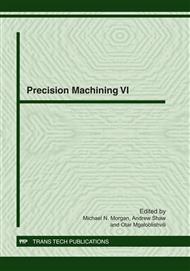[1]
Lemma, E., Chen, L., Siores, E., Wang, J., Optimising the AWJ cutting process of ductile materials using nozzle oscillation technique, Int. J. of Machine Tools & Manufacture 42 (2002) 781–789.
DOI: 10.1016/s0890-6955(02)00017-2
Google Scholar
[2]
Niu, M., Fukunishi, Y., Kobayashi, R., Experimental and numerical studies on the mechanism of abrasive jet cutting, Proc. of the 9th American Waterjet Conference, Dearborn, Michigan, 1997, p.145–156.
Google Scholar
[3]
Hlaváč, L., Physical model of jet - abrasive interaction, Proc. of Geomechanics 93, Ostrava, Balkema, 1994, pp.301-304.
Google Scholar
[4]
Hashish, M., On the modelling of surface waviness produced by abrasive-waterjets, Proc. of the 11th Int. Symposium on Jet Cutting Technology, St. Andrews, Scotland, September 8–10, 1992, p.17–34.
DOI: 10.1007/978-94-011-2678-6_2
Google Scholar
[5]
Chen, F.L., Siores, E., The effect of cutting jet variation on surface striation formation in abrasive water jet cutting, Journal of Materials Processing Technology 135 (2003) 1–5.
DOI: 10.1016/s0924-0136(01)00579-9
Google Scholar
[6]
Chao, J., Geskin, E.S., Experimental study of the striation formation and spectral analysis of the abrasive waterjet generated surfaces, Proc. of the 7th American Water Jet Conference, Seattle, Washington, August 28–31, 1993, p.27–41.
Google Scholar
[7]
Monno, M., Ravasio, C., The effect of cutting head vibrations on the surfaces generated by waterjet cutting, Int. J. of Machine Tools & Manufacture 45 (2005) 355–363.
DOI: 10.1016/j.ijmachtools.2004.07.010
Google Scholar
[8]
Lemma, E., Deam, R., Chen, F.L., Wang, J., Maximum depth of cut and other performance characteristics of the AWJ oscillation cutting process of ductile materials, Profiles in Industrial Research – Knowledge & Innovation, IRIS - Swinburne University of Technology, Melbourne, 2002, pp.57-63.
DOI: 10.1016/j.jmatprotec.2004.06.010
Google Scholar
[9]
Siores, E., Chen, L., Wong, W.C.K., Begg, R., Brandellero, S., Boundy, D., Improving surface finishing generated by the abrasive waterjet process, Advances in Abrasive Technology (1997) 187–191.
DOI: 10.1142/9789814317405_0035
Google Scholar
[10]
Hlaváč, L.M., Hlaváčová, I.M., Gembalová, L., Kaličinský, J., Fabian, S., Měšťánek, J., Kmec, J., Mádr, V., Experimental method for the investigation of the abrasive water jet cutting quality, Journal of Materials Processing Technology 209 (2009).
DOI: 10.1016/j.jmatprotec.2009.04.011
Google Scholar
[11]
Hloch, S., Fabian, S., Straka, L., Factor analysis and mathematical modelling of AWJ cutting, Proc. of the 5th Int. Conf. DAAAM Baltic Industrial Engineering - Adding Innovation Capacity of Labour Force and Entrepreneur, Tallinn, 2006, pp.127-132.
Google Scholar


